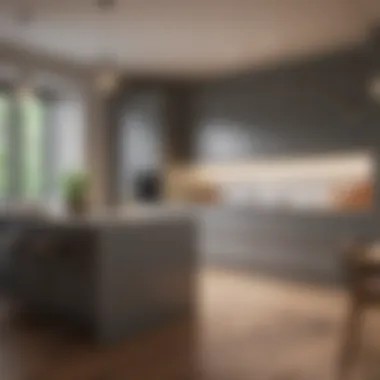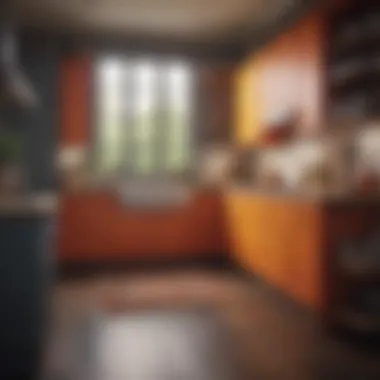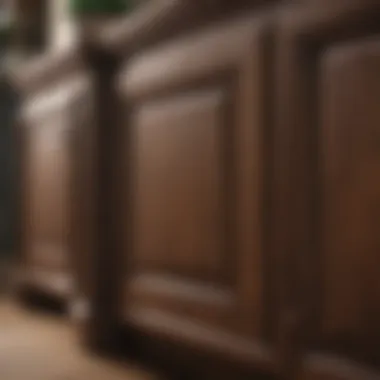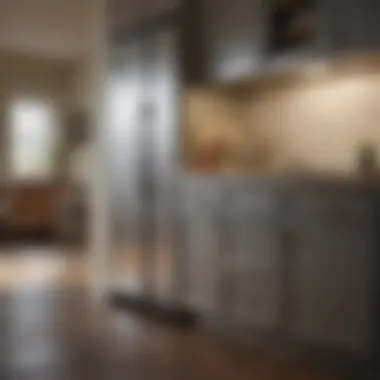Cost-Effective Cabinet Updates: Replace or Paint?


Intro
Homeowners often face significant decisions when it comes to updating their kitchen spaces. One of the most debated topics is whether to replace cabinet doors or simply paint them. Each of these options presents distinct financial and practical implications. This comprehensive evaluation aims to dissect the merits and drawbacks of both alternatives, helping individuals to make choices that align with their budgets and stylistic preferences.
This discussion draws on various elements including costs, installation processes, material durability, and long-term outcomes. Understanding these factors will empower homeowners to decide with clarity and confidence.
Key Insights and Trends
Exploring current trends in interior design can significantly enhance decision-making regarding cabinet doors. The contemporary aesthetic often favors clean lines and minimalism, leading many homeowners to lean towards replacement for a polished look. However, painting remains a popular choice due to its cost-effectiveness and versatility.
Factors shaping these choices include:
- Sustainability concerns: Many are choosing eco-friendly materials, which may influence their preference for replacing doors vs. painting existing ones.
- Personalization: Custom cabinet designs can add unique charm to a kitchen, making replacement a more appealing option for some owners.
- DIY culture: The rise in DIY projects encourages homeowners to consider painting, as it can offer a rewarding experience with immediate results.
Current market data suggest that painted cabinets can retain a significant portion of their value during resale. This highlights the importance of aesthetic updates that can be achieved without the need for completely new doors.
Practical Tips and How-To Guides
For homeowners contemplating whether to replace or paint cabinet doors, understanding the steps involved is crucial.
Step-by-Step Guide to Painting Cabinet Doors
- Preparation: Make a clean workspace. Remove all cabinet doors and hardware. Clean surfaces thoroughly.
- Sanding: Lightly sand the surfaces to help paint adhere better. Use a medium-grit sandpaper for effective results.
- Priming: Apply a primer suited for the material of your cabinets. This is especially important for achieving a smooth finish with lighter colors.
- Painting: Choose a high-quality paint. Consider using a spray gun for an even coat or a foam roller.
- Sealing: Apply a top coat or sealant to protect the paint and enhance durability.
Step-by-Step Guide to Cabinet Door Replacement
- Assessment: Evaluate the current cabinet structure and measure the space for new doors.
- Choosing Materials: Select suitable materials (wood, MDF, etc.) based on durability and design preferences.
- Installation Preparation: Gather tools needed for installation, including screws and hinges.
- Installing New Doors: Carefully align doors with existing frames, ensuring they open and close smoothly.
- Finishing Touches: Paint or stain the new doors as desired, and attach hardware.
Adapting these strategies according to individual needs can lead to refreshed kitchen spaces while being mindful of budget constraints.
Investing in new doors or opting for a fresh coat of paint can drastically change the atmosphere of a kitchen. However, the decision must consider both immediate costs and potential long-term benefits.
Preface to Cabinet Renovation Options
Cabinet renovation remains a central aspect of home improvement projects. Choosing how to approach this task—whether to replace or paint the kitchen cabinet doors—can greatly impact both finances and aesthetics. This article aims to provide a detailed examination of both options, enabling homeowners to consider their unique situations. By understanding the core differences and evaluating the cost-effectiveness of each method, potential pitfalls can be avoided, leading to better overall renovations.
Overview of Kitchen Cabinets
Kitchen cabinets serve a dual purpose: they provide essential storage and contribute significantly to the overall design of a home. Made from materials such as wood, metal, and laminate, these structures often define the style of the kitchen. When cabinets become worn or outdated, they can not only detract from a home's visual appeal but may also affect its functionality. It is crucial for homeowners to assess the condition of their cabinets regularly. Knowing when to reinvent these spaces can keep the kitchen both practical and inviting.
Reasons for Cabinet Updates
Several factors drive the decision to update kitchen cabinets:
- Wear and Tear: Over time, cabinets can become damaged or faded. Hinges may break, and surfaces may scratch easily.
- Changing Trends: As design trends evolve, older styles can make a kitchen appear dated. Updating the cabinets can refresh the space and enhance marketability.
- Personal Preference: Homeowners often wish for a different color or style to better match their changing tastes.
- Functionality Needs: A growing family may require more storage space or different layouts for better usage.
Ultimately, the importance of cabinet renovations is not just about aesthetics; it is also about enhancing the overall living experience.
Understanding Costs: An Overview


Understanding the costs associated with replacing kitchen cabinet doors versus painting them is crucial for homeowners aiming to make informed decisions. This section aims to provide clarity on financial implications, helping to equip readers with knowledge to effectively budget their kitchen renovation. Knowing the financial commitments can help prevent unexpected expenses that may arise during the process.
Defining 'Cheaper'
When discussing cost-effectiveness in renovations, the term ‘cheaper’ demands precise definition. Often, homeowners focus only on initial expenditures without considering long-term ramifications.
A lower upfront cost does not always equate to overall savings. For example, a cheap paint job might seem appealing; however, if the paint chips or fades quickly, it could necessitate frequent touch-ups. This raises future costs, negating any initial savings. In contrast, while replacing cabinet doors may demand a significant financial investment, the quality and durability could alleviate recurrent expenses over time. It is essential to distinguish between short-term savings versus long-term investments to deploy funds wisely.
Cost Breakdowns for Replacement
Materials and Labor
Replacement of cabinet doors involves sourcing quality materials and necessitates skilled labor for installation. Common materials include solid woods, laminates, or plywood, each with different costs. Solid wood, for instance, tends to be more expensive but offers sturdiness and longevity, enhancing overall value.
Labor costs also play a vital role, as experienced craftsmen demand premium rates. Despite the attractiveness of do-it-yourself projects, professional installation often ensures proper fitting and finishing, reducing hassle and potential future expenses. The combination of high-quality materials plus professional installation means homeowners get a reliable outcome but may face higher upfront costs.
Custom vs. Pre-made Options
When considering cabinet replacement, homeowners can choose between custom and pre-made options. Custom cabinets allow for tailored designs that fit specific dimensions or styles, which can enhance the kitchen's functionality. The downside, however, is typically higher cost and longer lead times.
Pre-made cabinets might offer a more budget-friendly alternative with quicker availability. These often come in standard sizes and design limitations, which might not satisfy everyone’s specific needs. While pre-made options can provide savings, they could lead to additional modifications later, affecting the overall budget.
Hidden Costs
Hidden costs present a significant aspect of home renovation that often gets overlooked. When replacing cabinets, expenses may arise from demolition, disposal of old materials, and potential repairs to underlying structures or flooring.
Homeowners should budget for these unanticipated expenses, as they can vary significantly, depending on the project’s magnitude. Understanding these hidden costs prepares individuals for potential financial surprises, aligning their budget more accurately with the renovation's true requirements.
Cost Breakdowns for Painting
Materials Needed
In painting cabinet doors, the costs are generally lower compared to replacement. Necessary materials might include high-quality paint, primers, brushes, and possibly some furniture repair supplies. Selecting top-notch paints specifically designed for cabinetry often yields better results, such as durability against wear. While the initial material cost may seem lesser, opting for inferior paint could result in premature wear, prompting early reapplication or complete repainting.
DIY vs. Professional Services
Deciding between DIY painting or hiring professionals presents significant implications for cost and outcome. A DIY approach usually appears more budget-friendly. However, it demands substantial time investment and skillset. Mistakes during the process can result in wastage of materials or poor finishes, leading to additional costs.
On the other hand, professional painting services might increase upfront costs but assure a quality finish due to experience. This choice can also save time and result in less stress. Weighing personal skills and availability can help determine which option is better.
Potential Ongoing Costs
Finally, considering potential ongoing costs tied to painted cabinets is wise. While the initial outlay might be attractive, regular touch-ups or reapplications can escalate expenses over time. Additionally, some paint finishes may not withstand kitchen humidity or heavy use well, leading to decreased durability.
Being aware of how paint will age in a kitchen environment informs homeowners about possible long-term costs. For best results, seeking paints labeled as durable and designed specifically for cabinetry can enhance longevity and reduce future expenditures.
Comparative Analysis: Replacement vs. Painting
Evaluating the differences between replacing cabinet doors and painting them is crucial for homeowners considering a kitchen update. This section offers insight into the financial implications, aesthetic outcomes, and long-term value associated with each option. Understanding these aspects will help homeowners make well-informed decisions that align with their specific needs and financial capacities.
Initial Costs of Each Option


The first factor to consider is the initial cost associated with each method.
- Replacement Costs: Investing in new cabinet doors involves several expenses. Homeowners must consider the price of materials, which can vary significantly based on the type of wood or laminate chosen. Labor costs for installation can also add to the total bill, especially if custom work is required. Prices for replacement can easily range from a few hundred to several thousand dollars depending on choices.
- Painting Costs: In contrast, painting cabinet doors often appears more budget-friendly. The primary expenditures include paint, primer, and tools. If a homeowner opts to do the work themselves, labor costs will be absent, making this a more economical route. However, hiring professionals may also lead to increased costs.
Long-Term Financial Considerations
While initial costs are important, evaluating long-term financial implications can provide a more comprehensive view.
- Durability and Maintenance: New cabinet doors usually come with warranties and are designed to last many years. They often require little maintenance, which can lead to cost savings over time. In contrast, painted cabinets may require touch-ups or repainting after several years, which could mean additional costs down the line.
- Potential Upgrades: Replacing the cabinet doors can allow for greater customization and integration of modern features. This might add to the initial investment but can enhance durability, negating unfavorable long-term financial outcomes.
Resale Value Implications
Another critical consideration is how each option affects home resale value.
- Replacement Impact: Homebuyers often prefer new, aesthetically pleasing cabinets. Replacing cabinet doors typically yields a much higher return on investment. Research shows that homes featuring modern kitchen finishes can sell faster and at higher prices.
- Painted Cabinet Value: While painting is more about personal style and can refresh the look of a kitchen, it often does not provide the same level of return on investment. Buyers may appreciate a clean, updated look but might hesitate if they sense the cabinets are not of high quality or need more maintenance.
"Ultimately, the decision between replacement and painting is not only about immediate costs but also about long-term value and aesthetics that can affect future home sales."
In summary, conducting a comparative analysis of replacement versus painting reveals a comprehensive understanding of various costs, long-term financial implications, and resale value considerations. Each method has its pros and cons, and gauging these factors will significantly benefit homeowners when making their decision.
Practical Considerations for Each Approach
When considering kitchen cabinet updates, it is essential to assess practical implications beyond just cost. This section reviews critical aspects such as durability and maintenance, installation challenges, and the time investment required for both replacement and painting. Understanding these factors is vital for homeowners who wish to make informed decisions that align with their lifestyle and long-term goals.
Durability and Maintenance
Durability is a key element in evaluating cabinet renovations. New cabinets, particularly those made from solid wood or high-quality materials, generally offer superior durability compared to painted surfaces. Replacing cabinet doors allows homeowners to choose materials that resist moisture, scratches, and wear over time. For example, solid wood doors provide a robust structure but require regular maintenance for longevity.
On the other hand, painted cabinets might need more frequent upkeep, especially in high-traffic areas. Paint can chip or peel, which might necessitate a repaint sooner than expected. Thus, homeowners should factor in not only the initial cost of painting but also the potential for future maintenance costs. Regular cleaning and minor touch-ups can help maintain the appearance of painted cabinets, but this effort demands time and attention, which some homeowners may not be willing to invest.
Installation Challenges
Installation varies significantly between replacing and painting cabinet doors. Replacement typically involves removing the old doors and hanging new ones, which can be straightforward if the measurements align. However, older cabinets may require adjustments or modifications during installation, which could lead to added costs.
Painting, in contrast, often requires extensive preparation. Homeowners must empty cabinets, clean surfaces, and possibly sand or prime to ensure proper paint adhesion. This process can be labor-intensive and may require multiple coats for an even finish. Depending on the condition of the existing cabinets, priming and sanding can become a challenging task. These considerations can dramatically affect the total cost curve.
Time Investment Required
Time is another crucial factor when deciding between replacement and painting. Cabinet replacement usually entails a wait for new doors to be created, delivered, and installed. Depending on the supplier and the complexity of the design, this could take days to weeks. However, once installed, new cabinets typically require minimal immediate attention.
Painting cabinets offers a shorter preparation time but can stretch into a lengthy project. Homeowners might spend several days painting, followed by curing time. Depending on the complexity of the design and finishing touches, a project that starts with high energy might require more stamina and patience to complete than originally planned.
"The choice between replacing and painting kitchen cabinets extends beyond mere cost; it engages aspects of time, durability, and personal commitment to the project's success."
In summary, a homeowner's decision should focus not only on immediate financial costs but also on the longevity of materials, ease of installation, and time commitments necessary for maintenance or renovations. An informed decision can lead to satisfying results that fit both aesthetic desires and functional needs.
Aesthetic Impacts: Visual Appeal
When considering kitchen renovations, the aesthetic impact of cabinet renovation plays a crucial role. Homeowners want their kitchens to reflect personal style while remaining functional. Visual appeal can significantly influence the overall ambiance of a kitchen. Thus, understanding how different renovation methods affect aesthetics is critical.
Design Flexibility of Painting


Painting cabinet doors offers a versatile approach to aesthetic enhancement. Homeowners can experiment with colors that align with current trends or personal preference. Unlike the rigid dimensions associated with replacement options, painting allows for a completely customizable look. One can opt for bold colors or softer hues depending on the desired mood of the space.
Additionally, painting permits creative techniques, such as distressing or adding textures, which can create unique designs tailored to individual tastes. Since paint can be easily changed, it allows for periodic updates without the substantial financial commitment associated with new cabinets. This adaptability can add significant value to a kitchen.
Variety in Replacement Cabinet Styles
Replacing cabinet doors introduces a different set of possibilities in terms of design. Here, one can choose from numerous styles, materials, and finishes which can transform the kitchen’s appearance entirely. Whether opting for modern sleek designs or classic wooden styles, the choices are vast.
Moreover, replacement cabinets are available in pre-made forms as well as custom options. This can allow homeowners to tailor their choice based on specific kitchen dimensions or layout. A well-chosen cabinet style can complement or redefine the kitchen’s theme, potentially increasing home value.
Environmental Considerations
In the quest to update kitchen cabinets, both replacement and painting present significant environmental considerations. Recognizing these factors can help homeowners make more sustainability-focused decisions. The choices made during renovation not only affect personal living spaces but also have broader implications for waste generation, resource use, and long-term environmental health.
Assessing the environmental impact of replacing cabinet doors involves understanding the entire lifecycle of the materials involved. New cabinets often come from virgin resources, which can lead to deforestation and habitat loss. Additionally, the production process may involve energy-intensive manufacturing practices, which contribute to carbon emissions. By weighing these factors, homeowners can appreciate the environmental toll of entirely new cabinets versus potential refurbishing options.
Painting cabinets, on the other hand, tends to present fewer immediate environmental challenges, especially if existing materials are reused. However, the type of paint used is crucial. Paints can contain volatile organic compounds (VOCs) that may harm indoor air quality and contribute to environmental degradation. Therefore, selecting paints that are low in VOCs or entirely eco-friendly can mitigate these risks, providing a greener alternative for cabinet updates.
Overall, the choice of either replacing or painting affects the overall footprint of kitchen renovations. This decision buys into a larger framework of sustainability, influencing how resources are allocated, affecting the waste management system, and contributing to the ongoing conversation about environmentally responsible home improvements.
Sustainability of Replacement
Replacing cabinet doors typically introduces a variety of new materials, which raises questions about sustainability. While new cabinets can provide an appealing look, many materials involved in their production, such as hardwood or engineered wood, require significant amounts of energy to obtain and process.
Manufacturers often utilize sustainable practices, such as sourcing wood from responsibly managed forests. Cabinets labeled with certifications like Forest Stewardship Council (FSC) or Sustainable Forestry Initiative (SFI) indicate that these materials have been harvested in ways that maintain ecological balance. However, such options are not standard across the board, and often homeowners must do their own research to ensure they're making eco-friendly choices.
Moreover, once the old cabinets are removed, they can end up in landfills, contributing further to waste. Reusing or recycling the old materials can greatly reduce this impact, but this requires an extra effort that may not be available to every homeowner.
Eco-Friendliness of Paint Options
When considering the eco-friendliness of paint options for cabinets, it is important to look beyond mere aesthetics. The chemical composition of paints can have significant consequences for both environmental health and indoor air quality. \n Homeowners can select eco-friendly paints that are formulated without harmful solvents or excessive VOCs. Brands like Benjamin Moore's Natura or Sherwin-Williams' Harmony offer non-toxic alternatives that maintain performance without compromising health.
Using these environmentally conscious paints helps prevent the release of harmful emissions during application and throughout the life of the product. Further, choosing to use water-based rather than oil-based paints can reduce environmental impact significantly.
Lastly, painting cabinets not only breathes new life into an existing structure but also limits resource consumption that comes with new replacements. By opting for quality paints and proper application, homeowners maintain a commitment to sustainability while achieving their desirable design goals.
Culmination: Making the Right Choice
As homeowners weigh options for updating cabinet doors, concluding which method is most suitable becomes critical. This article has explored the nuances of replacing versus painting cabinets, emphasizing that both options have their own merits and drawbacks. Making an informed decision requires evaluating how each option aligns with personal goals, budget constraints, and aesthetic aspirations.
Evaluating Personal Priorities
Understanding what is most important in the cabinet updating process is essential. Do you prioritize cost savings or aesthetic changes? If budget constraints are paramount, painting may offer significant savings with ample color choices and finishes. However, if durability and long-term use are critical, cabinet replacement might offer the best return on investment.
When choosing, consider factors like:
- Your budget for renovations
- How long you plan to stay in your home
- Desired quality and durability of materials
- Personal tastes and design preferences
- Effect on the overall property value
Assessing these priorities helps narrow down the choice and allows for a personalized decision-making process. This can determine whether the more labor-intensive and costly replacement is justifiable or if painting suffices for your needs.
Final Thoughts on Cost-Effectiveness
The cost-effectiveness of replacing cabinet doors versus painting them is not solely driven by immediate expenses. Long-term value, maintenance needs, and how each option affects home resale potential should be considered. Replacing cabinets may require a larger initial investment but may offer greater durability and longevity, reducing the need for future renovations. In contrast, while painting presents a budget-friendly choice, it may necessitate periodic upkeep more frequently than new cabinets would.
"Evaluate what best suits your lifestyle and home to make the right choice for your cabinet renovation project."
Ultimately, a thoughtful approach combining personal priorities with a clear understanding of financial implications will yield the best results. It is about more than just immediate costs; it is about crafting a space that reflects who you are while being mindful of your resources.



